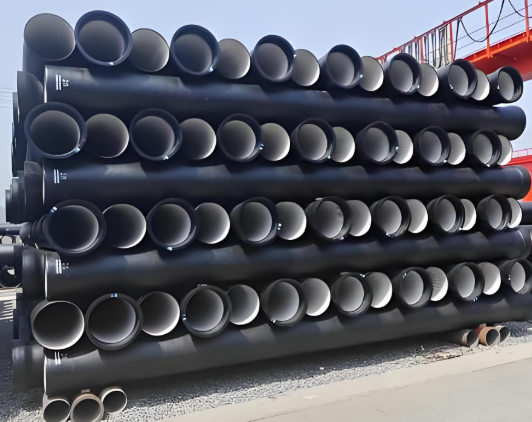Ductile iron pipes are the backbone of modern water and sewage systems, prized for their flexibility and resilience. But how exactly are these robust pipes produced?
Ductile iron pipes are made through a process called centrifugal casting, which involves pouring molten iron into a spinning mold. This spinning action helps distribute the material evenly, forming a pipe with a dense, durable structure. The molten iron is combined with small amounts of alloying elements, like magnesium, which give it increased strength and flexibility compared to traditional cast iron. After the pipes are formed, they undergo heat treatment to improve their toughness and resistance to corrosion. The final product is a strong, long-lasting pipe that is widely used for water distribution, sewage systems, and other underground infrastructure projects.

Raw Materials: The Foundation of Ductile Iron
The journey begins with carefully selected raw materials:
-
High-purity iron (94–96%).
-
Carbon (3–4%) for strength.
-
Silicon (1.8–2.8%) to stabilize graphite formation.
-
Magnesium (0.02–0.06%) for nodular graphite structure.
-
Trace elements like copper or nickel for corrosion resistance.
Step-by-Step Manufacturing Process
1. Melting & Composition Control
-
Scrap iron, steel, and alloys are melted in a cupola furnace at 2,550–2,750°F (1,400–1,500°C).
-
Spectrometers ensure precise chemical ratios for optimal ductility.
2. Nodularization: Creating Flexible Iron
-
Molten iron is treated with magnesium in a ladle. This transforms brittle flake graphite into nodular graphite, giving the iron its “ductile” properties.
3. Centrifugal Casting: Shaping the Pipe
- The molten ductile iron is poured into high-speed rotating molds (centrifugal casting).
- Centrifugal force distributes the metal evenly, creating seamless pipe walls.
- Common mold sizes: 3-inch to 64-inch diameters.
4. Heat Treatment: Enhancing Strength
- Pipes undergo annealing at 1,650°F (900°C) to relieve internal stress.
- A rapid air-cooling process (quenching) locks in durability.
5. Machining & Finishing
- Ends are machined to ensure smooth, precise joints.
- Zinc or epoxy coatings are applied for corrosion protection.
6. Quality Testing
- Hydrostatic tests: Pipes withstand 2–3x operating pressure.
- Ultrasonic scans: Detect hidden cracks or voids.
- Metallurgical analysis: Verify graphite nodule quality.
Why Centrifugal Casting Dominates Ductile Iron Pipe Production
| Method | Advantages | Limitations |
|---|---|---|
| Centrifugal Casting | Uniform wall thickness, high production speed | Limited to cylindrical shapes |
| Sand Casting | Complex shapes possible | Slower, rougher surfaces |
| Continuous Casting | Cost-effective for small diameters | Lower strength |
Key Properties Achieved During Manufacturing
- Tensile Strength: 60,000–100,000 psi (vs. 20,000 psi for cast iron).
- Elongation: 10–18% (can bend without breaking).
- Corrosion Resistance: Zinc/epoxy layers + inherent graphite protection.
Environmental & Efficiency Innovations
- Recycled Content: Up to 90% scrap metal reused.
- Energy Recovery: Modern plants capture furnace heat for power.
- Low Waste: Excess iron is remelted for new batches.
FAQs About Ductile Iron Pipe Production
Q: How long does it take to make a ductile iron pipe?
A: From melting to coating, the process takes 8–12 hours, depending on pipe size.
Q: Why is magnesium critical in production?
A: Magnesium triggers graphite nodule formation, which prevents cracks under stress.
Q: Can ductile iron pipes be recycled?
A: Yes—they’re 100% recyclable and often repurposed into new pipes or construction materials.
Industry Standards & Certifications
- ISO 2531: Global benchmark for water/wastewater pipes.
- EN 545: European standards for ductility and pressure ratings.
- AWWA C151: U.S. requirements for thickness and coating.
Conclusion: Engineering for Longevity
Ductile iron pipes owe their 100+ year lifespan to meticulous manufacturing—from magnesium-enhanced nodularization to precision centrifugal casting. By blending tradition with cutting-edge tech, producers deliver pipes that withstand earthquakes, heavy traffic, and corrosive environments.
References:
- Ductile Iron Pipe – Wikipedia
- ISO 2531: Ductile iron pipes, fittings, accessories and their joints for water applications – ISO
- AWWA C151 – American Water Works Association Standard for Ductile-Iron Pipe
- EN 545: Ductile iron pipes, fittings, accessories and their joints for water pipelines – European Committee for Standardization (CEN)
- American Foundry Society (AFS) – Industry Authority on Ductile Iron Manufacturing

